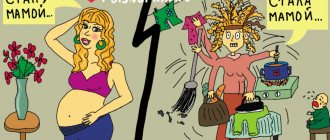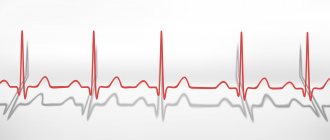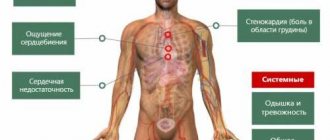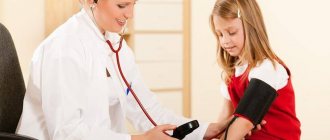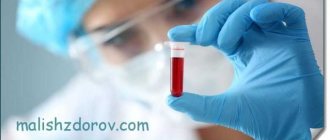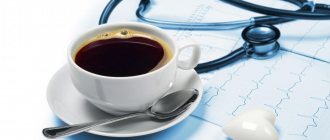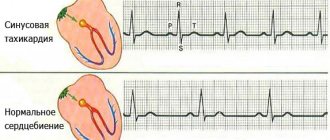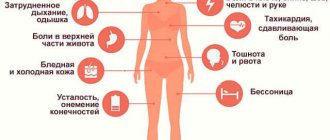What does tachycardia mean in a child?
Pediatric cardiologists consider it a disease when the number of heart beats per minute exceeds the norm by 20-30.
On a note! An impulse originates in the sinus node in the right atrium, which spreads to the atria and causes them to contract. The impulse is briefly delayed in the atrioventricular node between the ventricles and atria and transmitted to the ventricles, causing them to contract. The sinus node independently creates impulses within itself at a certain frequency. This is called "sinus rhythm."
Tachycardia is not an independent disease, but a sign of some other pathology. However, there is physiological tachycardia, which occurs during physical activity, emotional arousal, during eating, and when body temperature rises. This condition is completely harmless and does not threaten the child’s life. Tachycardia can occur even in a newborn child if he laughs, tries to make movements that are new to him, etc.
What is pulse?
The pulse is the rhythmic contraction of the walls of the arteries as a result of the contraction of the heart. Your pulse indicates your heart rate, or the number of times your heart beats in one minute. Heart rate varies from person to person. Your heart rate slows down when you are at rest and increases when you exercise because your body requires more oxygen-rich blood during exercise. Children's heart rate is normally higher than that of adults and it slows down with age. By about the age of 15, the pulse of a teenager and an adult is compared and has the same normal values. The normal indicators are shown in the table above.
Types of heart rhythm disorders
Tachycardia is divided into three main types :
- Sinus is the most common. With it, the heart rate in the sinus node increases. Most often appears during physical activity. However, it may be the first sign of vegetative-vascular dystonia of the hypertensive type and other diseases of the cardiovascular system.
- Paroxysmal (ectopic) - a sharp increase in the number of heart contractions by two or three times. Manifested by shortness of breath, abdominal pain, cyanosis of the skin and mucous membranes. Source: E.L. Boqueria Ectopic atrial tachycardia in children: clinical picture, diagnosis and treatment // Annals of Arrhythmology, 2006, No. 3, pp. 16-19
- Chronic – a condition in which a child’s blood pressure decreases, convulsions, suffocation, and chest pain occur. Treatment is usually lifestyle changes. Parents should protect the child from psycho-emotional and physical stress, monitor his daily routine, ensure proper nutrition and general hardening of the body.
Types of tachycardia
There are two types of childhood tachycardia - sinus and paroxysmal. In the first, the heart rate increases, but the sinus rhythm remains normal. This is especially common in infants, but is normal.
Sinus tachycardia has its own subtleties, and the reasons may lie in:
- Rapid growth of the body;
- Stress;
- Disorders of the endocrine and cardiovascular systems;
- Overwork.
Paroxysmal tachycardia is a process in which a sharp increase in heart rate occurs. Moreover, it appears as suddenly as it disappears. Such disorders occur in children of all ages, from infants to adolescents. Most often, children aged five years are susceptible to such attacks.
The causes of such attacks may be:
- Congenital or hereditary characteristics. For example, additional pathways in the heart;
- Poisoning or overdose of glycoside-containing drugs;
- Neuroses;
- Stress;
- Use of drugs such as alcohol or tobacco;
- Thyroid diseases;
- Diseases of the adrenal glands, expressed in excessive production of hormones;
- Diseases leading to water-electrolyte imbalance.
The main reasons are changes in the body, but not the heart.
Causes of the disease
Let us consider separately the causes of pathology in infants and preschoolers, schoolchildren, and adolescents.
Infants and preschoolers
In infants, severe tachycardia is considered to be a heart rate of more than 200 per minute. For preschoolers - depending on age, more than:
- six months – 185;
- 1 year – 160;
- 2 years – 150;
- 3 years – 140;
- 4 years – 135;
- 5 years – 120;
- 6 years – 115.
The reasons may be:
- fetal hypoxia during childbirth;
- anemia;
- dehydration of the body;
- fever;
- overheat;
- colds;
- congenital heart defects, which are diagnosed before birth and require constant monitoring. Source: A.I. Safina, I.Ya. Lutfullin, Z.A. Gainullina Heart rhythm disturbances in newborns // Practical Medicine, November 2010, No. 6(45), pp. 75-79
Often preschoolers do not want to do an ECG or even go to the doctor; they are capricious, worried, and cry. Under such conditions, an electrocardiogram will certainly show that the child has tachycardia. Therefore, it is better to conduct the study during sleep or after maximum calm.
Preschool children
Indicators of severe tachycardia are as follows (more than beats per minute):
- 7 years – 110;
- 8-10 years – 105;
- 11 years old – 104;
- 12 years old – 102.
The main reasons for an increase in heart rate at this age are emotional and physical stress. However, there are a number of diseases that cause such symptoms in this age group:
- myocarditis;
- primary rheumatic fever;
- long QT syndrome;
- Wolff-Parkinson-White syndrome.
In the last two syndromes, the tachycardia is not sinus. In Wolff-Parkinson-White syndrome, it is supraventricular, and the heart rate increases to more than 140 beats per minute. With an extended QT interval, paroxysms (increased) of ventricular tachycardia appear, fainting may occur, and the heart rate increases to more than 140 per minute. Source: https://www.ncbi.nlm.nih.gov/pmc/articles/PMC6595346/ Ranjit I. Kylat and Ricardo A. Samson Permanent junctional reciprocating tachycardia in infants and children // J Arrhythm. 2020 Jun; 35(3): 494–498
Teenagers
Severe tachycardia at this age is indicated when the pulse becomes more than (beats per minute):
- 13 years old – 100;
- 14-15 years old – 98.
The main reasons for an increase in heart rate in a teenager:
- rapid growth causing iron deficiency anemia;
- passion for diets;
- psychophysical fatigue;
- bad habits;
- poor physical fitness;
- excess production of thyroid hormones;
- high blood pressure;
- chronic pathologies of the heart and lungs.
Causes
In a child with a rapid heartbeat, an excess of the age-related parameters of the norm is recorded by more than 25–30 units. The reasons may be physiological (anatomical features of the heart in childhood):
- Small volume of cameras.
- Smaller vessel diameter.
At the same time, the blood supply needs of a rapidly growing child's body are constantly increasing. The reaction to all this will be a rapid heartbeat.
Other physiological root causes also include:
- excessive physical activity;
- stressful situations;
- temperature changes.
After eliminating the negative factors, heart activity is restored, and heartbeat parameters return to normal. If the condition persists for a long time and cannot be corrected at home, it is not recommended to delay consultation with a specialist and diagnostic procedures. There is a high risk of severe complications, for example, cardiomyopathy.
In addition to the above-mentioned age-related characteristics of the heart and the physiological root causes of increased heart rate, attacks of rapid heartbeat can occur against the background of various pathologies:
- endocrine disorders;
- after suffering infectious diseases;
- after bleeding;
- hyperactivity of the thyroid gland;
- for anemia, hypotension;
- abnormalities in the development of the cardiovascular system - rapid heartbeat in the fetus;
- side effects of certain subgroups of medications when taken for a long time.
Only a comprehensive examination - instrumental and laboratory - allows a specialist to collect information, assess the current condition and conduct an adequate differential diagnosis.
Symptoms of tachycardia in children
Symptoms and their intensity vary depending on the type of disease and its duration.
Main manifestations:
- vague discomfort in the heart area;
- feeling of heartbeat, heartbeat in the ears;
- lack of air, shortness of breath;
- pallor or blue discoloration of the skin and mucous membranes (in severe cases);
- weakness, fatigue, sluggish sucking in newborns;
- nausea due to dizziness;
- crying, anxiety;
- emotional arousal;
- faintness, loss of consciousness;
- sweating
Normal pulse and blood pressure
The heart rate at this age is variable, so standards exist only for average daily values. However, doctors rely on them both when examining a pediatrician and when describing an ECG.
The normal heart rate for a 5-year-old child is from 98 to 100 beats per minute at rest.
Therefore, before registering an ECG in the clinic, it is necessary that the child does not run or play with other children, but sits quietly for a few minutes. During this time, you can occupy him with a cartoon on a tablet, for example. We do not encourage the use of gadgets at such a young age, but recording an ECG is one of the times when you can use an electronic device to distract your child.
You can count your pulse at home. To do this, measure the number of pulse oscillations at the wrist (on the radial artery) for a minute. You can measure your pulse during sleep, but in this case it is lower than when you are awake, and mild bradycardia may be observed (85 - 97 beats per minute).
The normal blood pressure in a 5-year-old child is 100 – 116 / 60 – 76 mmHg. Art.
However, measurement using a conventional tonometer in children is not informative. It can significantly distort the indicators in any direction. Automatic blood pressure monitors often display an error message when trying to measure a child’s blood pressure. This can only be done using a special children's cuff for a tonometer; it is better to choose its girth up to 22 cm. There are also special children's automatic tonometers on sale.
Diagnostic methods
- Electrocardiography (ECG). After examining the printout, the doctor will be able to determine the type of tachycardia and see, for example, heart failure.
- Daily Holter monitoring is intended to detect paroxysmal tachycardia. Electrodes are attached to the baby's skin and connected to a compact device that takes readings around the clock. Sometimes it takes more than a day.
- Ultrasound of the heart (Echo-CG) - allows you to see the structure of the heart, structural abnormalities, visualize large vessels and heart valves and chambers, the thickness of the walls of the organ, and evaluate its contractile function. Ultrasound allows you to see heart defects.
- A clinical blood test aimed at detecting anemia. With it, a compensatory acceleration of heart rate occurs.
- Biochemical blood test for glucose levels and electrolyte composition.
- Blood test for thyroid hormones.
- Electroencephalography (EEG).
- MRI of the heart - in rare cases.
- Electrophysiological study (EPS) of the heart is necessary to evaluate electrical activity and find the source of impulses in the paroxysmal type of tachycardia.
Diagnostics
During the examination of the child, the doctor may ask the following questions:
- Does the child have a medical history, particularly sinus tachycardia, or any other heart condition?
- What was the onset and duration of the child’s current illness?
- Does the child have other symptoms, such as:
- chest pain;
- shortness of breath;
- change in skin color;
- loss of consciousness;
- neurological symptoms (eg, changes in level of consciousness);
- Is the child taking any medications?
- Does the child have an allergy to anything?
- Is there a family history of heart disease?
- Does tachycardia occur at a specific time or under certain circumstances (eg, during activity, after eating, under stress)?
- Has the child complained of feeling hot/fever?
- Has the child had vomiting or diarrhea?
- How often does your child drink and urinate?
In addition to a complete medical history and physical examination of the child, there are various types of procedures that may be used to diagnose TS. In particular, the following methods are used:
- Electrocardiography (ECG) is a measurement of the electrical activity of the heart. When electrodes are placed in certain places on the body (chest, arms and legs), a graphic image is created in the form of teeth of various heights and shapes. An ECG may indicate the presence of arrhythmia or other types of heart disease.
There are various options for an ECG test, including:
- Resting ECG (resting ECG) - to conduct this study, the child undresses to the waist, and then the doctor attaches electrodes in the form of small pads to the chest, shoulders and legs. On the other side, the electrodes are connected to an ECG machine. The device starts up and records the electrical activity of the heart for a minute or so. During this, the child lies quietly.
- Stress test . The child is connected to the measuring equipment as described above. However, instead of lying down, the child does the exercise by moving on a treadmill or “riding” a stationary bicycle. During the movement, an ECG is recorded. This test is carried out to assess the functioning of the heart during physical activity, which partly corresponds to the level of emotional stress.
- High resolution ECG . This procedure is performed in the same way as a resting ECG, except that the electrical activity of the heart is recorded over a longer period of time, usually 15 to 20 minutes. The method is used when arrhythmia is suspected, which is not recorded by a standard ECG, since rhythm disturbances can be short-term in nature and do not occur during recording in the usual way.
- Holter monitoring is an ECG recording that is performed over a period of 24 hours or more. To conduct the test, three electrodes are attached to the child's chest and connected to a small, portable ECG recorder using wires. The child goes about his or her normal daily activities (except for activities such as showering, swimming, or any activity that causes excessive sweating, which could cause the electrodes to fall off). There are two types of Holter monitoring: Continuous recording - the ECG is recorded continuously throughout the testing period.
- Event Monitor - An ECG is recorded only when the patient experiences a palpitations.
Differential diagnosis of sinus tachycardia with other types of arrhythmia
| Sinus tachycardia | Supraventricular tachycardia (re-entry) | Atrial fibrillation | |
| Clinic | May be absent or fever/sepsis/shock/anemia | 50% - Wolff-Parkinson-White syndrome 25% - atrioventricular, nodal, reentral tachycardia, Ebstein's anomaly | 90% have atrial dilatation/myocarditis/digoxin toxicity |
| Heart rate | Typically <200/min | Infants: <300/min, older children: <240/min. | Atrial rate 250-400/min 2:1, 3:1 or 4:1 with AV block |
| P wave | Normal | May be hidden in the QRS complex, 60% have retrograde P-wave | Regular flutter waves (F-waves) |
| QRS | Normal | Normal or aberrant | Normal |
Thus, sinus tachycardia has the most clinically favorable course, since other forms of arrhythmia are often accompanied by more pronounced and severe clinical symptoms.
Treatment of the disease
How to treat tachycardia will become clear after the cause is identified in the child. This pathology is treated by a cardiologist and other highly specialized specialists, depending on the results of the examination. For example, in case of problems with the thyroid gland, this will be an endocrinologist.
Important! If you find tachycardia in a child, then before consulting a doctor, exclude any stimulants from his diet - tea, coffee, chocolate, and protect him from stress as much as possible.
Therapy is selected individually, taking into account the underlying disease that caused the tachycardia. If a child has central nervous system dysfunction, a neurologist will prescribe sedatives. For heart pathologies, therapy is carried out by a cardiologist. At the same time, there are a lot of heart diseases, so treatment approaches vary. So, if an infection provokes myocarditis, then you will need to take an antibiotic. For autoimmune diseases that lead to arrhythmia, cytostatics and glucocorticosteroids are prescribed. Also, for any disease that causes tachycardia, the cardiologist can in any case prescribe a drug that will make the heart rate slower in order to relieve the load on the heart.
Treatment
Specific treatment for sinus tachycardia will be determined by the child's physician based on:
- Age, general health and medical history
- Degrees of clinical manifestations
- Tolerance of the child's body to specific medications, procedures or therapies
Sinus tachycardia may be present but not noticeable or cause any health problems. In this case, the doctor can only recommend adjusting your lifestyle, if necessary. However, when a rhythm disorder causes symptoms, there are several different treatment options.
As a rule, the doctor chooses treatment tactics according to the type of arrhythmia, the severity of symptoms, and the presence of other pathological conditions (for example, diabetes, kidney failure, heart failure, thyroid dysfunction) that may affect the course of treatment.
Most often, sinus tachycardia can be treated with lifestyle changes and medications. In other cases, the following therapy methods are used:
- Cardioversion . This procedure uses a low electrical voltage delivered to the heart through the chest to stop certain very rapid arrhythmias, such as atrial fibrillation, supraventricular tachycardia, or sinus tachycardia. The child is first given medication to help him relax and is then connected to an ECG monitor that works in parallel with a cardioversion device. A weak electrical current is applied to a specific point in the heart during an ECG cycle.
- Ablation is an invasive procedure performed in the electrophysical therapy department. It is carried out through a small thin tube (catheter) that is inserted into the heart through a vessel in the groin or arm. The procedure is carried out similarly to the electrophysiological study described above. Once the causative site of the arrhythmia is determined using EPI, the catheter is moved to it. The cause of the rhythm disorder can be destroyed using the appropriate technique: Radiofrequency ablation (the affected area is exposed to very high-frequency radio waves, which heat the tissue until it is destroyed)
- Cryoablation (part of the myocardium is exposed to an ultra-cold substance that freezes the tissue and then destroys it).
In infants and young children, pacemakers are usually placed in the abdomen. The wires that connect the pacemaker to the heart are placed on the outer surface of the heart. This precaution is necessary because fat in the abdomen protects the pacemaker wires and the device from shocks that may occur during daily childhood activities, such as standing up or falling.
For school-age children and teenagers, a pacemaker may be placed in the shoulder area under the collarbone. Pacemaker wires are often placed inside the superior vena cava, a large vein that connects to the right atrium, and then guided into the heart.
Surgery is usually performed only when all other modern therapies have failed to produce the expected results. Surgical ablation is a major surgical procedure requiring general anesthesia. The chest is cut open and open heart surgery is performed. The location of the arrhythmic focus is determined, then it is destroyed or removed, which eliminates the arrhythmia.
Video: What is cardiac tachycardia and how to treat it?
What to do if a child has an attack of tachycardia before the doctors arrive?
Until the ambulance arrives, there are several ways to alleviate the child’s condition:
The most important thing is to calm the child down, open a window or vent so that fresh air can enter the room. The following measures can then be taken:
- Wipe the child's face with cold water, and then place a cloth soaked in cold water on his face.
- Have your child close his eyes and then gently apply pressure to his eyeballs for a few seconds. This will provoke a reflex in which the heart rate decreases.
- Perform a Valsalva maneuver - the child should close his mouth and nose tightly and strain as if he wants to exhale.
- Massage the carotid sinus, that is, the place where the carotid artery divides into two branches - external and internal. This place is located approximately where the thyroid cartilage is on both sides of the neck. It’s easy to feel the thyroid cartilage; in men it’s called the “Adam’s apple.” After this, move your fingers slightly downward, and immediately under the Adam’s apple you will feel the carotid sinus with a characteristic pulsation. Apply pressure and massage for a few minutes. Source: L.A. Balykova, I.S. Nazarova, A.N. Silence Treatment of cardiac arrhythmias in children // Practical Medicine, September 2011, No. (53), pp. 30-37
Features of children's pulse
The pulse of a 5-year-old child is always higher than that of an adult. What does this mean:
- In a child's growing body, there is a need for increased oxygen content, accelerated delivery of nutrients and removal of metabolic products. That's why his heart beats faster.
- At this age, the size of the heart lags slightly behind the growth rate of the limbs and muscles, so a large load is placed on the cardiovascular system.
- The nervous system, which regulates the heart rate, excitability and conduction processes in the myocardium itself, does not yet function stable enough. In part, this can be attributed to an adaptive reaction that allows the child’s body to quickly adapt to the external environment. In addition, the functional usefulness of nervous regulation is established only towards the end of the child’s growth.
The pulse of a 5-year-old child is characterized by arrhythmia. Within a minute you can feel it slowing down and then speeding up.
This is usually associated with inhalation and exhalation, and this phenomenon is called respiratory arrhythmia. It is observed in most children, is not dangerous and does not require treatment. The reason for this condition is increased activity of the autonomic nervous system, which regulates the functioning of the heart.
Often the pulse has weaker filling, that is, the artery is easier to compress than in an adult. This is associated with lower blood pressure levels in children 5 years of age.
When measuring the pulse, there should be no interruptions, extraordinary contractions or “losses”.
Disease prevention
In order for not only the heart, but also the entire body to be strong and healthy, you must first normalize your diet. It is necessary to exclude all caffeine-containing drinks, as well as chocolate, fried foods and reduce the amount of sugar. The best diet is plant-based and dairy. Fruit juices and fresh vegetables are beneficial. Vitamin complexes will help reinforce the effect of the diet. The child must take magnesium and potassium, which normalize the heart rate. Consult your doctor first. And be sure to include moderate physical activity in your child’s daily routine, such as morning exercises. It stimulates the heart and increases its resistance to the release of excess adrenaline. As a result, irritability decreases and the emotional background normalizes. At the same time, you should not overexert yourself; any activity should be moderate. Swimming, for example, is very useful.
Sources:
- E.L. Boqueria. Ectopic atrial tachycardia in children: clinical picture, diagnosis and treatment // Annals of Arrhythmology, 2006, No. 3, pp. 16-19.
- A.I. Safina, I.Ya. Lutfullin, Z.A. Gainullina. Heart rhythm disturbances in newborns // Practical Medicine, November 2010, No. 6(45), pp. 75-79.
- https://www.ncbi.nlm.nih.gov/pmc/articles/PMC6595346/ Ranjit I. Kylat and Ricardo A. Samson. Permanent junctional reciprocating tachycardia in infants and children // J Arrhythm. 2020 Jun; 35(3): 494–498.
- L.A. Balykova, I.S. Nazarova, A.N. Silence. Treatment of cardiac arrhythmias in children // Practical Medicine, September 2011, No. (53), pp. 30-37.
The information in this article is provided for reference purposes and does not replace advice from a qualified professional. Don't self-medicate! At the first signs of illness, you should consult a doctor.
Causes of rapid heartbeat
Often, a fast heart rate is influenced by the environment and even who is taking the pulse measurement. To accurately determine how quickly the myocardium works, you need to observe the baby. Pulse measurements should be taken regularly, at the same time and in the same environment. It is advisable to feed the child an hour before the procedure and not give him or her any hot or cold drinks. Heart rate can be affected by:
- Times of Day;
- the position in which the pulse is measured;
- stuffy or too cold room;
- cold or hot food or drink;
- ARVI disease, influenza.
- age;
- weight;
- physical fitness and activity;
- taking medications;
- experienced stress.
It is important to be able to distinguish pathological tachycardia from the body’s normal physiological reaction to physical activity and from anxiety.
Frequent heartbeat in a child is not a separate disease, but a consequence of disturbances in the functioning of other organs, or the occurrence of an infectious disease. If your child complains of chest pain, that his heart is about to jump out, or that his heart is beating rapidly, but he has not done any physical activity or experienced stress, you should consult a doctor. A child may have a strong heartbeat due to:
- diseases of the endocrine system;
- problems with hormones;
- anemia;
- lack of vitamins;
- chronic fatigue;
- increased blood pressure;
- myocardial diseases;
- fever;
- purulent infections;
- sleep disorders;
- chest injuries;
- increased intracranial pressure.
Prices
| Name of service (price list incomplete) | Price |
| Appointment with a cardiologist, treatment and diagnostic, primary, outpatient | 1750 rub. |
| Consultation with prescription of a treatment regimen (for up to 1 month) | 1800 rub. |
| Consultation (interpretation) with analyzes from third parties | 2250 rub. |
| Consultation with a candidate of medical sciences | 2500 rub. |
| Electrocardiography (ECG) | 1400 rub. |
| Echocardiography (ultrasound of the heart) | 3500 rub. |
Bradycardia
A decrease in the heart rate of a 5-year-old child below normal is combined with a slow heartbeat and is called bradycardia. It is also conventionally divided into degrees of severity:
| Degree of severity for a 5 year old child | Mild bradycardia | Moderate bradycardia | Severe bradycardia |
| Heart rate per minute | 85 — 97 | 70 — 84 | Less than 70 |
Reasons for the decline
A slow heart rate is not typical for children. Physiological causes of this condition include hypothermia and malnutrition. The following can cause a slow heart rate:
- hypothyroidism (decreased hormonal activity of the thyroid gland);
- hypokalemia (decreased potassium levels in the blood with severe vomiting);
- severe hypoxia (oxygen starvation of tissues).
Mild bradycardia may be an individual feature, while the pulse easily rises to normal during physical activity and is not accompanied by weakness and dizziness. This condition does not require treatment. The main options for pathological slowing of the pulse.
- Sick sinus syndrome
At the same time, the heart rate does not accelerate during stress or exercise. The main causes of this condition in children are surgical correction of congenital heart defects, cardiomyopathies, myocarditis, Kawasaki disease, and rare hereditary diseases.
- Drug poisoning
Accidentally taken medications by a child can cause the heart rate to drop below normal. These are digoxin, beta blockers, calcium antagonists, clonidine, lithium salts.
- Increased vagal tone
Vagotonia is a fairly common phenomenon characterized by increased activity of the vagus nerve. It can manifest itself especially strongly during sleep, causing not only a slowing of the pulse, but also the appearance of episodes of sinoatrial or atrioventricular block with pauses in the heart. Pathological vagotonia can appear under the influence of the following factors: overdose of proserin, vomiting, cough, breath holding, tracheal intubation, nasopharyngeal tube.
- Atrioventricular block II – III degree
This rhythm disturbance is accompanied by severe bradycardia, up to 50 - 70 per minute and lower. The reasons for such deviation of the pulse from the norm in a 5-year-old child: congenital heart defects (for example, Ebstein's anomaly), consequences of heart surgery, rheumatic fever, infective endocarditis, myocarditis, diphtheria, Lyme disease, digoxin poisoning. There are also congenital atrioventricular blocks, the cause of which may be the mother's disease with systemic lupus erythematosus.
If the heart rate of a 5-year-old child constantly decreases below normal, it is better to consult a doctor and find out the cause of this condition.
Medical diagnosis
If the heart rate of a 5-year-old child is not normal, the doctor may prescribe the following tests:
- blood tests to look for anemia and signs of infection;
- blood test for potassium, TSH and T4;
- ECG;
- daily ECG monitoring is the only way to find out the average daily heart rate and determine whether there are actually changes in the pulse, or whether they are temporary and caused by some external influences;
- EchoCG (ultrasound of the heart) to detect defects, signs of endocarditis and other diseases;
- spirometry (external respiration function) to assess the state of bronchial patency and lung function.
Timely identification of the causes of heart rate deviations from the norm in a 5-year-old child will help to begin treatment on time.
Usually it includes normalization of the regime, nutrition, and therapy of the underlying disease. Congenital heart defects require surgical correction. If a child is diagnosed with complete atrioventricular block, he needs pacemaker implantation.
Treatment methods
Most attacks of sinus tachycardia occur unnoticed. Treatment is required if the child experiences obvious discomfort or the attack lasts more than 10 minutes. The doctor, based on the results of the diagnosis and examination, will be able to draw up a treatment plan. It usually looks like this:
- compliance with the rules of prevention;
- taking vitamin complexes, sedatives;
- use of vagal tests;
- surgical intervention.
Surgeon assistance may be required if thyrotoxicosis or pheochrocytoma is present. The essence of the operation is to remove the pathological area of the gland. Other types of intervention are also used, depending on the cause of the abnormal heart rhythm.
Medicines are prescribed exclusively by the attending physician. Self-administration of medications can cause the development of side effects (bradycardia, hypotension, allergic reaction).
Drug treatment
Treatment of more advanced cases involves taking medications:
- Sedatives (Phenibut, Tenoten for Children, Phytosedan) are used to reduce excitability and normalize the functioning of the nervous and cardiovascular systems.
- Preparations based on magnesium and potassium (Panagin, Asparkam) eliminate arrhythmia by improving impulse conduction, regulating pressure and maintaining optimal vascular tone.
- Iron-based products (“Aktiferrin”, “Totema”) help eliminate arrhythmia caused by anemia.
- Cardiac glycosides (Digoxin, Celanide) are used to improve heart function and stabilize blood pressure.
If the sinus form of tachycardia is a consequence of various diseases, then after their elimination the arrhythmia will go away. The basis of treatment is methods aimed at stopping the causative factor.
First aid measures
Parents should learn what to do during an attack to alleviate the child's condition. The list of effective methods for reducing heart rate is as follows:
- Remove clothing from the neck and chest area for better air intake.
- Place the child on a bed in a well-ventilated area or take him outside.
- Give sparkling water to drink.
- Apply vagal tests.
- Apply cold compresses to the head and neck. If the case concerns a child under 2 years old, then this method is contraindicated.
Vagal tests stimulate the vagus nerve through physical stimulation, thereby reducing the intensity of heart contractions. Not all of them are suitable for stopping an attack in children due to the characteristics of a young body. A list of the most effective and safest methods is given below:
- Take a deep breath and hold your abdominal muscles tense. After 10-15 seconds, exhale through pursed lips. Perform the test 7-8 times.
- Close your eyes and pull them slightly over your eyelids. After 10-15 seconds, reduce the strength. Repeat 5-6 times.
If the attack cannot be stopped, you will need to call an ambulance. The arriving doctors must be told about the actions taken.
Prevention
Regardless of the form of tachycardia, the child must be taught a healthy lifestyle. The following rules will help with this:
- play sports (without overload);
- maintain a sleep and rest schedule;
- be examined annually;
- body weight control;
- staying in a calm environment at home and at school;
- follow the doctor's recommendations;
It is equally important to adjust your diet by removing fatty foods and reducing the amount of sweets consumed. It is better to diversify the daily menu with vegetables, fruits, and berries. It should be cooked by steaming or boiling. It is advisable to avoid fried and smoked foods.
Sinus tachycardia is considered one of the most common forms of arrhythmia in children. If it has a physiological nature, then there is nothing special to worry about. The situation with a pathological type of failure is completely different. The child will have to be examined to identify the causative factor and eliminate it. Medicines combined with compliance with the rules of prevention will help with this.
Treatment with traditional methods
To cure a disease, you first need to eliminate the cause of its occurrence. If the cause of the development of tachycardia was stress, then it is necessary to create favorable living conditions for the child so that he does not experience nervous shock. If the disease appears as a result of viral infections, then it is necessary to strengthen the immune system and take vitamins to reduce the risk of their development to a minimum.
If the cause of tachycardia is heart pathology and dysfunction, then the cardiologist will prescribe comprehensive treatment, including medication. It is important to understand that medications should not be given to a baby without being prescribed by a specialist, otherwise the child may be harmed. It is also necessary to follow all the doctor’s recommendations and in no case exceed the dose of the medicine, as this is also unsafe.
When treating the disease, namely its paroxysmal form, cardiologists most often prescribe medications such as Izolanid and Amiodarone, which help normalize heart rhythm and cellular metabolism. If the attack is isolated, then it is possible to eliminate it with the help of sodium bromide and magnesium sulfate diluted with novocaine.
Features of the pathology
The diagnosis of tachycardia is made when the heart rate increases. With the sinus form of the disease, this figure can increase by 60%. The problem arises when the sinus node, which controls the rhythm of the heart, is disrupted in the conduction of impulses.
The disease can occur in mild, moderate and severe degrees.
Before the age of sixteen, major changes occur in the body. During this period, a significant increase in the size of the heart occurs. Due to immaturity of blood vessels, blood pressure in the arteries increases.
In childhood and adolescence, the development of sinus tachycardia is not considered a pathology, but a symptom.
This may indicate heart failure, dysfunction of the left ventricle, anemia, hypoglycemia, tumors and other diseases. Therefore, the child must undergo examination.
Your actions
Provide the maximum amount of fresh air
If this happens, and before your eyes the baby develops tachycardia, then you need to know how to behave in such a situation, how to help the child, alleviate his condition.
- Take care to increase fresh air in the room where the little one is.
- If possible, unbutton your clothes, freeing your neck and chest.
- Soak a handkerchief, diaper or towel in cold water and apply it to the baby's forehead.
Cardiac tachycardia in newborns
Tachycardia in newborns is not such a rare situation in pediatric practice. Changes in heart rate occur mainly in the first three days of life and are a reflection of cardiac and extracardiac pathological processes.
Moreover, even the smallest rhythmic deviations can be a manifestation of severe organic heart damage.
Tachycardia in a newborn child can occur without pronounced clinical symptoms, or it can manifest as severe failure of the heart muscle and end in sudden cardiac death, which only increases the severity of this pathology.
Causes of attacks of tachycardia in newborns
As you know, parents may encounter two types of the described pathology: the sinus and paroxysmal variants of tachycardia.
The first is due to an increase in the automatism of the sinus node, from which the main stimulus emanates, leading to contraction of the muscular layer of the heart.
The causes of tachycardia in newborns in this case come down to conditions such as congenital heart defects and acute asphyxia. Also, the described disease can be a consequence of anemia, especially hemolytic, in which the breakdown of red blood cells occurs due to Rh conflict or the action of an infectious process.
Increased heart rate of this type can also develop as a result of decreased blood sugar. This is especially likely if the woman suffered from diabetes during pregnancy. Perinatal encephalopathy may also be a cause.
It must be remembered that such a variant of rapid heartbeat may be a natural phenomenon, the appearance of which can be explained by physiological reactions to external factors, for example, emotional arousal or severe fear.
Paroxysmal tachycardia in a newborn has slightly different causes. This type of pathology is associated primarily with a disorder of myocardial function, although there are cases when the described condition developed without any apparent reason.
In this case, myocarditis is most often the culprit for the increased beating of the heart muscle. In second place you can put various heart defects. Dystonia of the vegetative type, in which, as is known, the tone of the sympathetic nervous system predominates, can also lead to the development of tachycardia. Nervous shocks also play a role in the development of pathology.
The paroxysmal type of tachycardia in newborns is always considered as a more dangerous option. Unlike the sinus type of increased heart rate, this type of pathology is never a normal variant.
This disease is divided into three forms: atrial, atrioventricular and ventricular. Due to the fact that the first two are very difficult to differentiate from the point of view of practical medicine, it is advisable to divide this type of cardiac arrhythmia into supraventricular and ventricular tachycardia.
Symptoms of tachycardia in newborns
In the case of the development of the sinus form of the pathology in question, a strong heartbeat comes to the fore in the clinical picture. However, the sinus rhythm characteristic of a normal healthy heart is maintained.
Sinus tachycardia in newborns is in most cases considered as a variant of the norm, since the culprit of this condition is usually the increased automaticity of the main driver of the heart rhythm - the sinus node.
The symptoms in this case are identical to the manifestations of the disease in adults. In addition to increased heart rate, chest pain, dizziness and fainting are common. Shortness of breath and sweating develop. Nausea often occurs. There is lethargy and pale skin.
The behavior of babies changes: they are more capricious, become restless, their appetite and sleep suffer.
Recognition of the described rhythm disturbance is often difficult, because many signs of pathology can suggest completely different diseases.
Paroxysmal tachycardia in newborns, the symptoms and treatment of which are mainly discussed below, in contrast to the sinus type of pathology, is a more serious condition that requires closer attention from doctors.
An attack of the disease usually begins suddenly. The baby experiences a sensation of an abnormally strong heartbeat. In this case, there is a feeling of lack of air and dizziness develops.
Here it is worth paying attention to the fact that infants, due to known characteristics, are not able to complain of cardiac discomfort. This suggests that parents should always monitor the baby’s condition very carefully and, at the first alarming symptoms, seek help from doctors.
Signs that may indicate tachycardia in a newborn include weakness in the body, increased sweating and pallor of the skin. When the pathological condition in question occurs, nausea and polyuria are also noted.
The heartbeats become so fast that it is impossible to calculate their frequency. If you perform auscultation (listening), you can hear that the heart sounds have acquired a flapping character. And if you look at the baby’s neck, you can notice the swelling of the veins.
With a prolonged attack, symptoms of heart failure appear in the form of low blood pressure, decreased diuresis and the development of shortness of breath.
Ventricular tachycardia in a newborn baby
The ventricular form of the described pathology is observed quite rarely, but its symptoms are considered to be very dangerous ailments.
In this case, the onset of an attack of tachycardia in newborns cannot be clearly established. The baby is always in serious condition during an attack. All of the above manifestations occur, but their severity is much more intense.
A child with a similar diagnosis experiences attacks of suffocation and severe pain in the chest, plus he experiences convulsions. The pulsation of the neck veins does not correspond to the frequency of the peripheral pulse. The spleen and liver are subject to enlargement.
When chronic, cardiac tachycardia in newborns leads to persistent disturbances in the movement of blood through the vessels, which creates an immediate threat to the life of the baby.
Any type of pathology under consideration should not be deprived of the attention of medical specialists. Any changes in condition can cause extremely negative consequences. Therefore, the health of the baby depends entirely on the timeliness of visiting doctors.
In the case of sinus tachycardia, there may be no need for special therapy. Often it is enough to plan the daily routine, perhaps change the climate, bring the nervous system to a state of rest.
Paroxysmal tachycardia in a newborn must be treated without fail.
At the same time, the most common drugs prescribed by doctors to children suffering from this disease are Amiodarone, Digoxin and Izolanide.
In simple cases, Novocaine is prescribed in combination with sodium bromide and magnesium sulfate. If such a complex does not give the desired result, it is advisable to use Novocainamide.
In addition, for tachycardia in newborns, treatment can be carried out with medications such as Sotalol and Propafenone. However, in the presence of organic heart damage, the effectiveness of the latter medicine is significantly reduced.
If refractoriness to the above therapeutic agents is detected, infants are given Amiodarone, which is often prescribed in combination with Flecainide. But in this case, there is a serious drawback - prolonged use of Amiodarone can cause the child to develop pulmonary fibrosis.
This article has been read 9,021 times.
Congenital hepatitis occurs in children born to mothers who are carriers of the corresponding type of virus. At the same time, Botkin’s disease (hepatitis type A) is extremely common...
Children often become infected with pinworms, so it is important to know how to cope with such a disease. Enterobiasis in young children is a disease in which…
Sometimes it happens that babies look thin. This may be due to malnutrition. Malnutrition in children under one year of age is a nutritional disorder of a young child, ...
Rickets is a disease of a growing organism associated with insufficiency of phosphorus-calcium metabolism, leading to disruption of bone formation, functions of the nervous system...
Children get ulcerative colitis quite rarely (15 out of 100 people), but in recent years such cases have become more frequent. Moreover, in half of them the disease is chronic...
A boil is a purulent inflammation of the hair follicle and surrounding tissues. That's why they appear only on those parts of the body where there is hair growth, more often...
Acne is a skin disease that is most often observed in adolescents, i.e., during puberty. They arise as a result of inflammation of the sebaceous gland and blockage of its ducts. ...
Every loving and attentive mother always notices even the most minor changes in her child’s body. What can we say about changes in skin color...
One of the most terrible diseases in children is encephalopathy. This word is used in medicine to denote a list of non-inflammatory processes in the brain...
Among all the existing manifestations of an allergic nature characteristic of infants, atopic dermatitis is one of the most serious diseases. Earlier …
Almost all parents are familiar with the situation when a healthy baby suddenly begins to sob uncontrollably, pressing his legs to his stomach. The stomach itself tenses and swells. ...
The group of diseases called respiratory includes all diseases associated with breathing disorders (in Latin this word sounds like respiratio, which is where it comes from...
Intestinal colitis and enterocolitis in children can be both infectious and non-infectious. The classification of these inflammatory pathologies is carried out according to etiology, ...
The reasons for the development of pyelonephritis in children can be different. At an early age, it can develop as an independent disease, as well as after previous illnesses...
Diphtheria, coded in ICD-10 as A36, is considered primarily a childhood infection, which today doctors can counter with the most modern preventive ...
Families raising a child with cerebral palsy have a very difficult time. For many children, the diagnosis of cerebral palsy sounds like a death sentence, because such children often...
In the modern world of ubiquitous allergens and uncontrolled use of immune stimulating agents, specific pathologies of autoimmune origin are developing. ...
Like many diseases, diabetes mellitus has psychological causes, and the psychosomatics of this disease have been studied quite well. Constant conflicts...
Source: https://med-pomosh.com/?p=6313
Cardiac tachycardia in newborns
Tachycardia in newborns is not such a rare situation in pediatric practice. Changes in heart rate occur mainly in the first three days of life and are a reflection of cardiac and extracardiac pathological processes. Moreover, even the smallest rhythmic deviations can be a manifestation of severe organic heart damage.
Tachycardia in a newborn child can occur without pronounced clinical symptoms, or it can manifest as severe failure of the heart muscle and end in sudden cardiac death, which only increases the severity of this pathology.
Forms of childhood tachycardia
Moderate tachycardia in a child is most often perceived as normal. But if attacks of increased heart rate occur frequently, for no apparent reason and are of a pronounced nature, this may indicate the presence of a pathology, which can take two forms:
- sinus infantile tachycardia;
- paroxysmal tachycardia.
The sinus type of tachycardia means that the sinus node, which is responsible for generating impulses that trigger myocardial contractions, does not work correctly, generating unnecessary electrical impulses. The second cause of this type of tachycardia may be various conduction disturbances along the sinus node-ventricles route.
Increased automatism of the sinus node in newborns causes an increase in heart rate and is usually not considered a pathology.
Source: https://AptekaTamara.ru/bolezni/tahikardiya-u-rebenka.html
Prevention
For normal well-being, the following measures are recommended:
- maintaining a healthy weight - extra pounds put a strain on the heart;
- regular exercise;
- limited consumption of products containing caffeine;
- healthy diet, with a limited amount of fats and fast carbohydrates;
- a calm environment in the educational institution and at home;
- giving up bad habits - smoking, alcohol, which increase the manifestations of tachycardia.
As you can see, the child’s health depends on the attention of parents and adequate, timely treatment . Therefore, if there are frequent attacks of tachycardia, the child should be shown to a doctor. Then the chances of a full recovery increase.
Treatment of pathology
Emergency help
During an attack, you must follow these recommendations:
- let fresh air into the room;
- cover the child's forehead with a cold towel;
- contact a specialist.
If tachycardia is of the paroxysmal type, then first aid depends on the location of the origin of the abnormal impulse. For the supraventricular form, the following steps must be taken:
To alleviate his condition, the baby should push with his nose closed.
- Child 3-4 years old: close the baby’s nose and ask him to push;
- massage the carotid artery.
- press on the root of the tongue;
If an attack of the ventricular form occurs, then help is provided with drugs:
- Intravenous administration of "Lidocaine 1%" approximately 1-1.5 mg/kg.
- If the attack does not subside, then you need to administer a solution of Gilurythmal 2.5%, diluted with 10-20 ml of sodium chloride 0.9% in an amount of 1 mg/kg.
- If the attack continues, Amiodarone 5% diluted with glucose 5% is administered - 10 ml.
Medicines
Treatment of tachycardia in children with medication is carried out only as prescribed by a doctor, who can adjust the dosage and course of therapy depending on the patient’s condition. Frequently prescribed drugs are presented in the table:
| Group | Drugs |
| Sedatives | "Seduxen" |
| "Luminal" | |
| "Valerian" | |
| "Asparkam" | |
| Potassium-containing | |
| Cardiac glycosides | "Digoxin" |
| "Verapamil" | |
| Beta blockers | "Pindolol" |
Surgery
Sometimes a patient's problem can be solved with the help of a pacemaker.
If other treatment options have not brought positive results, the attending physician may decide to perform surgery. Surgical procedures for tachycardia:
- Radiofrequency ablation. The method is based on the destruction of areas that supply the wrong impulse.
- Introduction of a pacemaker. An artificial pacemaker maintains the correct heart rate.
- Heart valve surgery. The operation is performed if there are certain congenital abnormalities.
Healers' recipes
Mild sinus tachycardia is treated with alternative medicine methods. Any influences can be carried out only after consultation with a specialist. Effective recipes:
- Motherwort infusion. One tbsp. l. dry herbs should be steamed with 1 cup of boiling water and left for 60 minutes. Strain the mixture, add 3 drops of peppermint oil, 1 tsp. honey The composition must be mixed and drunk. The course of therapy is 30 days.
- Valerian root decoction. Two tsp. The root is mixed with 1 teaspoon of dry dill, lemon balm, and hop cones. The mixture is poured with 350 ml of boiling water and left for half an hour. Drink 200 ml of the decoction before meals.
- Herbal collection. Mix 10 grams of horsetail, motherwort and hawthorn and add 0.5 liters of water. The mixture is heated in a water bath for 20 minutes and then cooled for 50 minutes. The strained tincture is taken 50 ml 4 times a day.
Survey
Diagnostics includes the following activities:
- general blood test - determines the composition of the blood and allows you to identify leukemia, anemia, and other dangerous pathologies;
- blood test for thyroid-stimulating hormones - shows deviations in the functioning of the thyroid gland;
- urine test for adrenaline - excludes or confirms the hormonal nature of the symptom;
- ECG, or electrocardiogram - by the frequency and rhythm of heart contractions, changes characteristic of various heart ailments are found;
- Holter ECG (24-hour monitoring) - shows how the heart works under different loads (at rest, movement, sleep);
- bicycle ergometry - study of heart function during physical activity;
- Cardiac echocardiography or ultrasound examination - reveals pathologies of the sinus node;
- electrophysiological study - detects conduction disturbances;
- electroencephalography (EEG) of the brain - detects diseases of the central nervous system.
This is what sinus tachycardia looks like in children on an ECG:
During the examination, the child is also interviewed. Because infants and toddlers are unable to accurately describe their sensations, diagnosis at this age is difficult.
